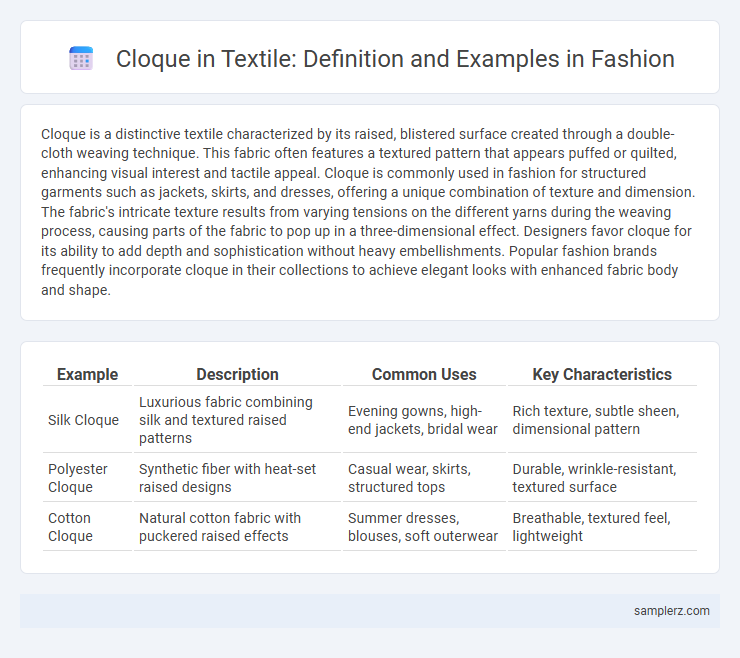Cloque is a distinctive textile characterized by its raised, blistered surface created through a double-cloth weaving technique. This fabric often features a textured pattern that appears puffed or quilted, enhancing visual interest and tactile appeal. Cloque is commonly used in fashion for structured garments such as jackets, skirts, and dresses, offering a unique combination of texture and dimension. The fabric's intricate texture results from varying tensions on the different yarns during the weaving process, causing parts of the fabric to pop up in a three-dimensional effect. Designers favor cloque for its ability to add depth and sophistication without heavy embellishments. Popular fashion brands frequently incorporate cloque in their collections to achieve elegant looks with enhanced fabric body and shape.
Table of Comparison
| Example | Description | Common Uses | Key Characteristics |
|---|---|---|---|
| Silk Cloque | Luxurious fabric combining silk and textured raised patterns | Evening gowns, high-end jackets, bridal wear | Rich texture, subtle sheen, dimensional pattern |
| Polyester Cloque | Synthetic fiber with heat-set raised designs | Casual wear, skirts, structured tops | Durable, wrinkle-resistant, textured surface |
| Cotton Cloque | Natural cotton fabric with puckered raised effects | Summer dresses, blouses, soft outerwear | Breathable, textured feel, lightweight |
Understanding Cloqué: Definition and Origins
Cloque is a textured fabric characterized by its raised, blistered surface created through a double-cloth weaving technique that causes puckering effects. Originating from French textile design, cloque evolved as a sophisticated material used commonly in high fashion for its unique dimensional pattern, often found in jackets, dresses, and upholstery. Its distinctive three-dimensional appearance adds visual interest and depth, making cloque a favored choice for designers seeking luxurious and tactile fabric options.
Key Characteristics of Cloqué Textiles
Cloque textiles are distinguished by their raised, blistered surface texture achieved through woven or knitted fabric manipulation. This fabric often features a puckered or quilted appearance created by variations in tension or yarn thickness, resulting in a three-dimensional effect. Commonly crafted from silk, cotton, or synthetic fibers, cloque is prized for its luxurious feel, durability, and elegant visual depth in fashion applications.
Cloqué vs. Other Textured Fabrics
Cloque fabric features a unique raised, blistered surface created by weaving or stitching, setting it apart from other textured textiles like brocade or jacquard that rely on intricate woven patterns. Unlike crepe, which achieves texture through twisted yarns, cloque emphasizes dimensionality with its puckered, quilted effect that adds tactile interest without heavy embellishment. This distinctive surface makes cloque ideal for structured garments, offering both aesthetic depth and a subtle three-dimensional quality unmatched by smoother textured fabrics.
Historical Evolution of Cloqué in Fashion
Cloque fabric, characterized by its quilted or puckered texture, gained prominence in early 20th-century haute couture, notably in the 1920s and 1930s, when designers like Coco Chanel incorporated it for structured elegance. Throughout the decades, cloque evolved from luxury evening wear to more accessible pret-a-porter collections, reflecting shifts in textile technology and consumer demand. Contemporary fashion continues to embrace cloque for its dimensional surface, blending traditional craftsmanship with modern innovation in fabric production.
Common Materials Used for Cloqué Fabrics
Cloque fabrics are commonly crafted from polyester, cotton blends, and silk to achieve their distinctive puckered texture. These materials allow the fabric to maintain its three-dimensional, quilted appearance while offering durability and comfort. Synthetic fibers like nylon are sometimes incorporated to enhance elasticity and wrinkle resistance in cloque textiles.
Cloqué in Contemporary Fashion Design
Cloque fabric, characterized by its raised, blistered surface texture, is prominently utilized in contemporary fashion design to create visually striking and tactilely rich garments. Designers employ cloque in structured dresses, tailored jackets, and avant-garde pieces that emphasize volume and depth without excessive layering. The fabric's three-dimensional quality enhances modern silhouettes, offering both durability and an elegant, textured finish that aligns with current trends in innovative textile manipulation.
Iconic Cloqué Garments in Runway History
Iconic cloque garments in runway history showcase the fabric's distinctive puckered texture, creating dramatic volume and intricate patterns that elevate couture designs. Designers like Cristobal Balenciaga and Alexander McQueen have prominently featured cloque in sculptural dresses and structured jackets, emphasizing the textile's luxurious depth and tactile appeal. Cloque remains a favorite in high fashion for its ability to combine texture with elegance, making garments visually striking and immediately recognizable.
Styling Tips: How to Wear Cloqué Pieces
Cloque fabric, known for its raised, textured patterns, adds a sophisticated dimension to any outfit, perfect for elevating both casual and formal looks. Pair cloque jackets or skirts with sleek, minimalist accessories to balance the bold texture, while neutral colors help highlight the fabric's intricate details. For best results, combine cloque pieces with smooth materials like silk or satin to create contrasting textures that enhance overall style and visual interest.
Care and Maintenance of Cloqué Fabrics
Cloque fabrics, characterized by their raised, bubble-like texture, require gentle care to preserve their structural integrity and aesthetic appeal. Hand washing in cold water with mild detergent and avoiding wringing or twisting helps maintain the fabric's unique texture, while air drying flat prevents deformation. Storing cloque textiles away from direct sunlight and excessive humidity extends their lifespan and prevents discoloration or fabric deterioration.
Future Trends: Cloqué in Sustainable Fashion
Cloque fabric, characterized by its raised, textured patterns, is gaining traction in sustainable fashion due to its ability to add depth and dimension without heavy embellishments. Future trends highlight the use of eco-friendly fibers like organic cotton and recycled polyester in cloque textiles, promoting durability and low environmental impact. Innovations in waterless dyeing technology are further enhancing cloque's appeal as a sustainable option in high-end and everyday fashion collections.

example of cloqué in textile Infographic
 samplerz.com
samplerz.com